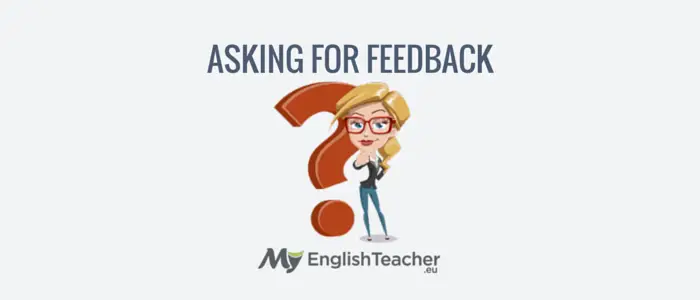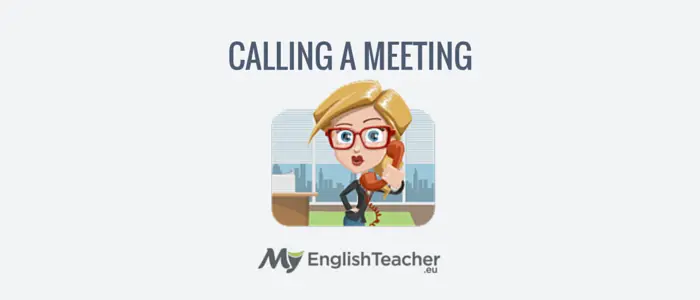Business English phrases for meetings.
Meetings play a very big part in the business world. During meetings, important decisions are made, people are promoted, demoted, hired or even fired!
The future of companies is predicted, business tactics are analysed, competitors are targeted and strategies are planned.
A lot of time is spent organising, attending, hosting and holding meetings, so understanding your position in the meeting and knowing how to provide input is essential.
In this post, I will aim to provide all the valuable information you need to be equipped with when you enter that meeting room.
Useful English Phrases For Running A Business Meeting
1. SAMPLE PHRASES FOR GETTING STARTED ›› WELCOMING ›› MAKING INTRODUCTIONS AND APOLOGIES
- Right, everyone has arrived now, so let’s get started.
- If we are all here, let’s start the meeting.
- Now that everyone is here, shall we begin?
- Shall we get down to business?
- Well, since everyone is here, we should get started.
- Okay, we have a lot to cover today, so we really should get started.
- Hello everyone. Thank you for coming today.
- Okay, let’s begin. Firstly, I’d like to welcome you all.
- Thank you all for coming at such short notice.
- I really appreciate your attendance to this meeting.
- For those of you who don’t know me yet, I am …
- Please join me in welcoming …
- I’d like to extend a warm welcome to …
- We are pleased to welcome …
- Firstly, I’d like to introduce …
- For anyone who hasn’t met our new … yet, this is …
- It’s a pleasure for me to welcome …
- I’d like to take a moment to introduce …
- I know most of you, but there are a few unfamiliar faces. I am …
- (Name) has kindly agreed to take the minutes today.
- (Name) will be presenting the …
- (Name) has kindly agreed to give us a report on …
- (Name), would you mind taking notes / taking the minutes today please?
- (Name) will lead (topic) from the agenda.
- (Name), would you like to kick off with …?
- Unfortunately, Margaret cannot join us today. She was called away on urgent business.
- Mark will be taking the minutes today, as Sarah is at home with a fever.
- I have received apologies for absence from …
- If you notice anyone missing, please let Mark know so he can make a note of it.
2. PHRASES TO USE FOR OUTLINING PRINCIPAL OBJECTIVES AND INTRODUCING THE AGENDA
- We are here today to talk about …
- We are here to discuss …
- Our main aim today is to …
- I’ve called this meeting today in order to …
- As you can see here on the agenda …
- Firstly, we’ll be talking about …
- First of all, we’ll discuss …
- After that, we’ll be looking at …
- Followed by …
- If time allows, we will also cover …
- Then, I’ll be handing it over to … for …
- Secondly, we’ll look at …
- Next, I’ll ask you for (feedback, comments, your opinion, your views, suggestions, ideas) on …
- And finally, we’ll discuss …

FOLLOWING THE AGENDA
All the attendees should somehow see or receive a copy of the agenda, whether this is handed out to individuals on paper, shown on an overhead projector screen or written on a board in the meeting room.
All the attendees should be able to follow the agenda as the meeting progresses, be fully aware of which topic is being discussed and what stage the meeting is at.
Before beginning the first item on the agenda, it is also customary to outline the principal objectives and provide a brief verbal outline of the agenda.
Read more:
A Practical Guide to Using Diplomatic English in a Business Environment
Tell me about yourself: How to introduce yourself in English: Tips and Phrases
3. PHRASES TO USE FOR KEEPING THE MEETING IN AN EFFECTIVE FLOW
- That’s a valid point but we will discuss that in more detail at a later date.
- Okay, let’s talk more about that later on.
- I’m afraid we’ll have to come back to this later.
- We’re running short on time, so let’s move on to the next topic.
- We’re running behind now, so let’s skip to the next point on the agenda.
- I’m afraid we only have 10 minutes left, so let’s move on to….
- We’ve spent too long on this issue now, let’s discuss it in more detail after this meeting.
- I think we’ll have to leave that there for now and move on to….
- We’re pushed for time, so let’s discuss….
- Let’s try to stay on topic, that can be discussed another time.
- You can discuss that amongst yourselves after the meeting.
- This matter is not on today’s agenda, let’s leave it for next time.
- Let’s save this for another meeting.
- Getting back to the task at hand….
WATCHING THE TIME
(Staying on track or getting back on track)
As I mentioned before, this is usually the main issue with meetings and the thing that attendees would be most likely to complain about.
A successful meeting is one that starts and finishes at the allotted time, with all the points on the agenda fully covered.
It is the host’s (or chairperson’s) responsibility to ensure that the meeting does not go off topic, and that it stays within a suitable timeframe.
Read more:
5 Decision Making Business English Phrases
4. ASKING FOR OR OFFERING SUGGESTIONS OR FEEDBACK
- I couldn’t agree with you more (I agree)
- I completely agree with …
- Could I just say one thing please?
- If I could just come in here …
- I would just like to add …
- May I come in here please?
- Sorry, could you speak up a little please? I can’t hear you at the back.
- If I could have a chance to speak for a moment please.
- I’m glad you brought that up. I’d like to add …
- I’m afraid I’d have to disagree with you on that.
- I would just like to say that …
- Excuse me for interrupting …
- I really feel that …
- The way I see things …
- In my opinion …
- (Name), could you please tell us how … is progressing?
- (Name), how is the … coming along?
- Next, (name) will talk us through …
- (Name, have you managed to complete the …?
- (Name), when can we expect to hear about …?
- Has everyone received a copy of …?
- (Name), can we have your input on … please?
- How do you feel about …?
- Are you positive that …?
- What do you think about …
- What are your views on …?
- Now, I’d like to hand over to (name), who will talk about …
- This brings us to the next topic on the agenda, which will be introduced by (name).
- Why don’t we move on to …
- If no one has anything else to add, let’s move on to …

Attendees will generally be asked to provide input by giving their opinion, making comments or suggestions, providing feedback or asking questions.
It can sometimes be hard to have your say if many people would like to comment at the same time.
5. ASKING FOR CLARIFICATION
(When you don’t understand something)
- I don’t quite follow you. What exactly do you mean?
- I don’t see what you mean. Could you elaborate please?
- I’m afraid I don’t quite understand what you’re getting at.
- Could you please explain to me how that is going to work?
- Do you mean that …?
- So what you’re saying is that … (repeat what they said to get confirmation)
- You did say … didn’t you?
- Could you spell that please?
- Would you mind spelling that for me please?
- (repeat what they said in your own words) … is that what you mean?
- Is it true that …?
- Correct me if I’m wrong please, you’re saying … (reiterate what they said)
If you do not understand what is being said by someone in particular, instead of just letting it pass by, you should ask for clarification to ensure that you are on the same page (that you understand), because they may be talking about something that will also affect you!
Other useful expressions that could be used:
Other ways to say ‘On the other hand’
Other ways to say ‘For example’
Other ways to say ‘I don’t know’
Other ways to say ‘As mentioned previously’
6. BRING THE MEETING TO A CLOSE
(Ending the meeting)
- Is there any other business?
- Does anyone have any other business?
- Any other business?
- Would anyone like to make any final points?
- If there are no further points, I’d like to bring the meeting to a close.
- Before we close the meeting, I’d like to briefly summarise the main points …
- Let me quickly go over today’s main points.
- To sum up …
- Right, why don’t we summarise what we’ve agreed on today.
- Shall I go over the main points before we adjourn?
- I guess that will be all for today, thank you for taking part.
- I think we should finish here.
- We seem to have been very efficient today, so let’s wrap up early.
- We have covered everything on the agenda, so let’s end it here.
- If there is nothing else to add, I’d like to adjourn the meeting.
- If there are no other comments, I’d like to wrap this meeting up.
- It looks like we’ve finished ahead of schedule, so let’s finish up here.
- I’m afraid we’re going to have to cut this meeting short. I’ve just been informed of an urgent matter that needs to be dealt with immediately.
- I’m afraid we’ll have to end this meeting here. Let’s rearrange and continue this discussion another time.
- Thank you all for your input today.
- Thank you for your participation.
- Let’s end this here, shall we? I’m sure you all have other important work to get back to.
- Before you leave, please remember to sign the attendance sheet
- I almost forgot to mention….
- I’d like to thank (name) for …
- Sorry, could I please have your attention for one more moment. I forgot to say…
- Before we go, let’s put our hands together for (clap or say congratulations)….
- Most of you probably know this already, but I’d like to formally congratulate….
- Please don’t forget to hand in your votes by the end of the week.
- I look forward to receiving emails from you all about your final vote.
- The minutes of the meeting will be sent to you all by (person’s name and/or time/date) …
- If anyone has any further questions, or would like to give any feedback privately, then please feel free to email me.
Once all the topics on the agenda have been covered, it is time to adjourn (end) the meeting. If the meeting is running over time, then it may be necessary to skip (not discuss) any less important topics, and end the meeting once all the main topics have been covered.
Sometimes, a meeting may even finish early, if everything is covered ahead of time! You should always end the meeting by summarising the main points or decisions made (if needed) and thanking everyone for coming.
This could also be the time to make any last minute remarks or reminders, or say a special thanks or congratulations to anyone.
7. CALLING A MEETING
(Organising and hosting a meeting)
If you feel there is something that needs to be discussed amongst the team, you may want to ‘call a meeting’, or you may be ‘called to a meeting’ by another colleague or superior.
Meetings can be announced verbally in small teams, posted on bulletin boards or (most commonly these days) attendees are invited by email. If a verbal announcement is made, it should always be followed up by written confirmation.
When contacting the prospective attendees, it is important to mention the time, date, place and topic/purpose of the meeting.
If you are expecting to cover many topics, you should also send out an agenda (list of topics that will be discussed) so the attendees know what to expect and can prepare any questions, comments or information they would like to add to each point.
Likewise, if you are called to a meeting and would like to prepare beforehand, don’t be afraid to ask the host (or chairperson) for a copy of the agenda!
If anyone is expected to ‘have the floor’ (host a part of the meeting) or provide specific information, then don’t forget to notify them in person (or by phone if they’re not nearby!) of their duty, so they have time to prepare.
Read more:
Formal and Informal Email Phrases Starting with Greetings, Finishing with Closing Phrases!
19 Email Templates for Business Communication

SAMPLE EMAIL FOR CALLING A MEETING:
To: [email protected]; [email protected]; [email protected]; [email protected];
Cc: [email protected]; [email protected];
From: [email protected];
Subject: Early Quarterly Meeting
Good Afternoon Everyone,
There will be a meeting next week Thursday (26th) at 3pm in Room 5C. All staff in the marketing team are expected to attend, as we will be discussing our strategy for the next quarter.
We’re having this meeting earlier than usual due to the sudden surge of popularity surrounding our latest product. Please come prepared with ideas, queries, suggestions for further promotions and any questions, as we will not have time to discuss this during peak time.
Please expect the meeting to last approximately 3 hours.
Yours,
Nadine Thomas
Marketing Supervisor
8. WRITING AN AGENDA
(Preparing the itinerary/topics for discussion during the meeting)
One common issue that occurs with meetings is that they tend to run over the allocated time. If the attendees are told to keep 1 hour free for the meeting but are then occupied for 2.5 hours, then not only are they neglecting other important work, but it could also be very costly for the company.
One popular idiom to describe this would be ‘Time is money’ . If carefully organised and appropriately hosted, then a meeting CAN run smoothly.
Having clear aims, setting time limits per topic, sticking to the agenda, and knowing how to ‘get back on track’ are key components of an effective meeting.
The attendees will be more likely to provide input by asking questions and offering feedback if they know what to expect.
Read more:
1000+ Most Popular English Idioms and Their Meanings
SAMPLE AGENDA
MEETING AGENDA
Marketing Strategy for Quarter 2 – Thursday 26thFebruary – Room 5C
15:00 – Welcome / Introduction / Refreshments
15:20 – Minutes from previous meeting
15:30 – Quarter 1 so far – Presentation by Dominic
16:00 – Positive effects of latest product
16:20 – Issues and limitations
16:40 – Feedback from last quarter
17:00 – New ideas for Q2*
17:45 – Media attention / expectations
18:00 – Questions / Reminders / AOB**
* Q2 is short for Quarter 2 i.e. the second quarter of the year (April to June).
** AOB is short for ‘Any Other Business’ (anything else that someone would like to discuss) and is very commonly used in meetings.

9. SAMPLE PERSONAL REQUEST
Nadine: Hi Dominic. How are you?
Dominic: Fine, thanks. Is there something I can help you with?
Nadine: Yes, I’m planning on having next quarter’s meeting early this year and I was wondering if you could prepare a PowerPoint presentation about Quarter 1 so far, just so everyone is up to date with what has been going on so far. Could you do that please?
Dominic: I’m afraid I’m quite busy this week…when is the meeting?
Nadine: I was planning on arranging it for next week Thursday at 3pm.
Dominic: Okay, that’s fine. That gives me time to prepare a slideshow over the weekend. No problem!
Nadine: Thank you Dom, I really appreciate it. I’ll allocate a 30 minute slot to you for the presentation, as there is a lot to cover. Does that suit you?
Dominic: Yes, I should be able to fit everything into that timeframe.
Nadine: Great, thanks again. Let me know if you get stuck on anything (if you have any problems).
ALLOCATING ROLES
(Assigning specific duties to other members of staff)
The person hosting the meeting may decide to allocate roles to other staff, such as taking minutes during the meeting (keeping a record of who attends and what is discussed), speaking about a certain subject, providing figures or data on a specific topic.
If you are allocated a role by the meeting host, then remember to ask questions about anything you don’t understand, rather than guessing…because it’ll be too late to prepare again once the meeting has begun!
If you are hosting the meeting and would like to allocate a role to someone, remember to give them plenty of notice so they can prepare what you have asked them to do.
Also, ask them if they are able to take on this role before you announce to everyone that they will be doing it, just in case they cannot.
Read more:
70 Remarkable Sports Idioms You Can Use In Business And Daily Life
10. TAKING THE MINUTES
(Recording the meeting)
This usually consists of keeping a list of the attendee’s names, and recording everything that is discussed, in case it needs to be discussed again or reviewed in the future.
Generally, someone who is not participating in the meeting would be called upon to be the minute-taker, but anyone may be assigned this responsibility, so it is good to be ready for it, in case your manager asks you to do it.
Before the meeting begins, the minute-taker should obtain a copy of the previous (related) meeting’s minutes, a copy of the agenda for the new meeting and have a list of who is supposed to be attending, to hand.
If you are not familiar with taking minutes, then it may be good to have an outline before going into the meeting to help guide you through everything that needs to be recorded. A standard outline should include:
- The topic of the meeting / main items on the agenda
- Meeting details (time, place, host, start time, end time)
- A list of attendees to be ticked off (or a blank list for attendees to sign)

SAMPLE MINUTES OUTLINE:
MARKETING STRATEGY FOR QUARTER 2
Thursday 26th February – ROOM 5C
Start Time:________ End Time:________
Meeting hosted by: _________________
Attendee Name: Signature:
1.
2.
3.
4.
Main topics on the agenda:
- Quarter 1 Presentation by Dominic
- Pros and cons of latest product
- Q1 Feedback from team
- Ideas for Q2
- Media attention
Notes:…..
The minute-taker can choose to record the meeting on paper (handwritten) or on a computer (typed up), whichever you feel more comfortable with.
You will more than likely be asked to type the minutes up later, so that it can be stored electronically and sent around to all the attendees after the meeting – this should be done immediately after the meeting so that you don’t forget any of the points that were mentioned (even your own scribbled notes can seem hard to understand after a while)!
Many people who are very familiar with minute-taking tend to use shorthand writing, which enables you to write a lot quicker and keep up with the discussion.
If you are called upon to take minutes on a regular basis, then it may be worth learning how to do shorthand writing!
Remember, you do not need to record every single word that is spoken! Only a brief outline of what is discussed, and all significant points that are made by any of the participants.
For example, if someone mentions an issue that needs to be dealt with, something positive that is working really well, and any feedback or suggestions.
Any key points surrounding the main topics of the meeting should definitely be recorded, as well as any votes or decisions.
It is, sometimes, also important to record who said what, for this reason, the minute-taker should know the names of the attendees.
If you don’t know their names, you should make a note of their seating position and ask their names at the end of the meeting.
If the meeting is with a very large number of people who are not known to one another then, generally, it is customary for them to introduce themselves (mention their name or company name) before they say anything else.
Read more:
7 Simple Examples of Business Email Writing in English

11. OPENING A MEETING
(Starting the meeting)
At the start, while the attendees are arriving, having refreshments or getting settled into their seats, it is polite to make small talk with others (polite conversation about unimportant or uncontroversial matters).
This usually fills any awkward silences while people are waiting to begin.
Once everyone has arrived, the person hosting the meeting should formally welcome everyone to the meeting, and thank them for coming.
If there is a new person in the meeting, or a guest attendee who does not know the others, this would be the best time to make introductions.
Followed by the roll call (checking to see if all the attendees are there) and any apologies that need to be made on behalf of an important figure or a regular attendee who couldn’t make it.
If the meeting is a small group then roll call is usually not necessary, as the person taking the minutes will be able to make a note of who was there.
In a larger meeting, or one with guests whose names are not known, an attendance sheet should be sent around.
Read more:
Discover How to Be a Successful Negotiator in English Once and for All
So, now you should be able to successfully call a meeting, write an agenda, assign roles to others, take minutes, open a meeting, stay on track and close a meeting!
I hope the information provided in this blog helps you to feel more confident when you enter a meeting room, knowing that you are armed with all the main phrases that you may need to use.
Read more:
How NOT to Look Stupid. English for Secretaries and Assistants
If you think there is anything else that should be included in this blog about meetings, then please let me know!


























Awesome! Thank you!
thank you so much its really very helpful … Great help to me
Really useful,
Thank you! 🙏
Really very useful.
Thank you!
AWESOME